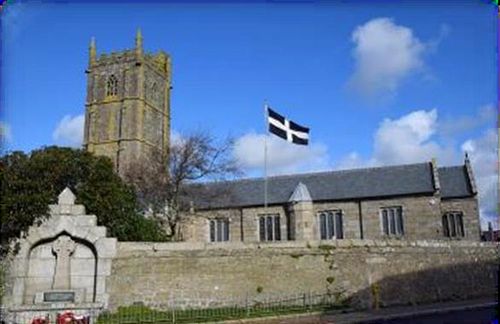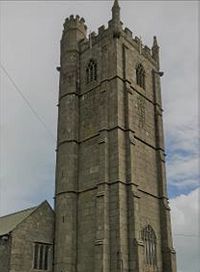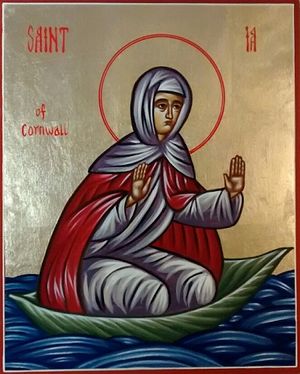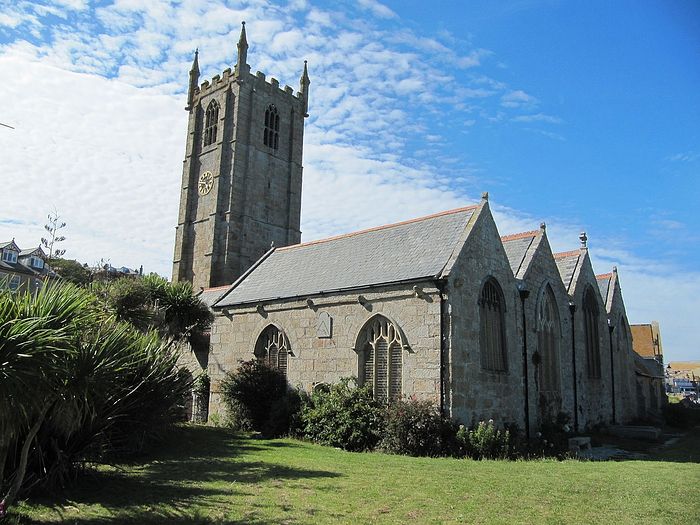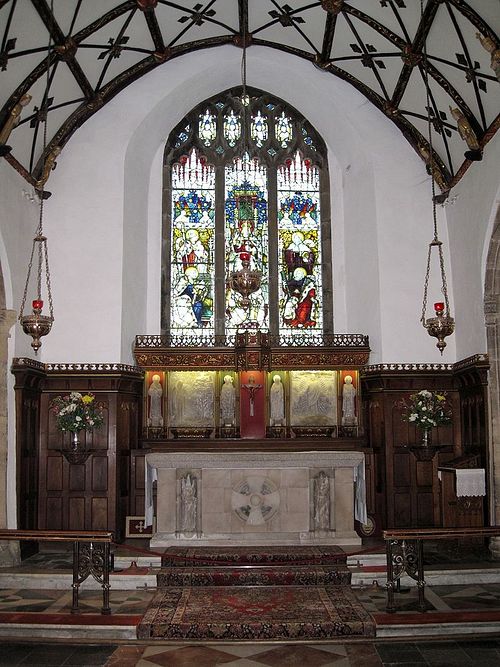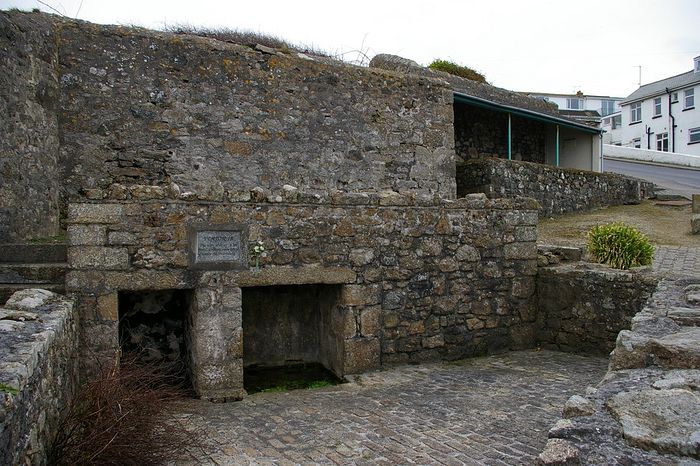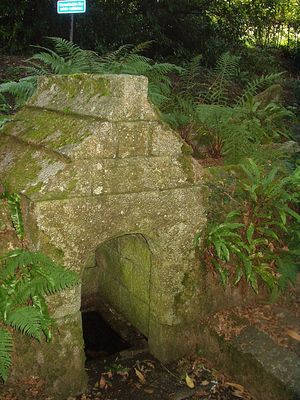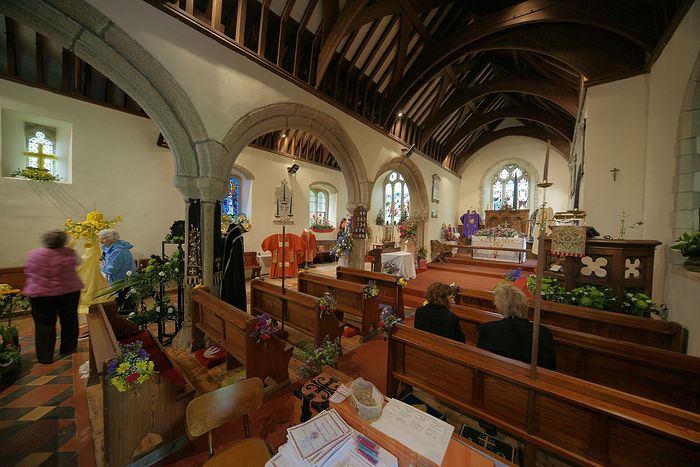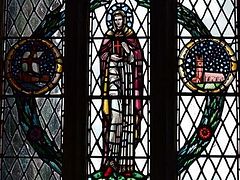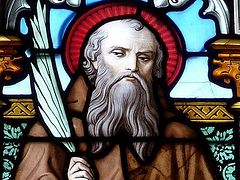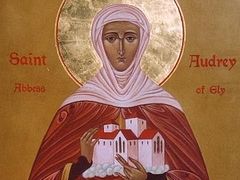Saint Buriana of Cornwall
Commemorated June 14/17 and May 1/14
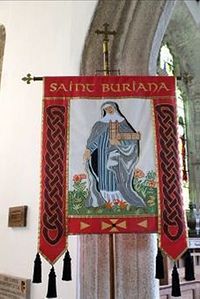 The modern St. Buriana's banner at St. Buryan church, Cornwall (provided by the rector of St. Buryan church)
The modern St. Buriana's banner at St. Buryan church, Cornwall (provided by the rector of St. Buryan church) Legends associated with this saint abound. It is known that Buriana was famed for her beauty. One day a local ruler fell in love with her and abducted the virgin in order to marry her. Having learned about this, St. Piran immediately pled for her, begging the ruler to set her free. The king did not want to free the beautiful maiden, yet he was afraid not to obey a priest of such great authority. Then the unlucky suitor resorted to cunning and said that he would liberate Buriana on the condition that he would be woken up the next morning by a cry of a cuckoo. And it was winter… Only a miracle could save the abducted saint.
 The bronze statue of St. Buriana inside St. Buryan church, Cornwall (provided by the rector of St. Buryan church)
The bronze statue of St. Buriana inside St. Buryan church, Cornwall (provided by the rector of St. Buryan church) St. Buriana was buried at St. Buryan and many miracles occurred at her grave. By the tenth century the place still had a well-organized community. In 930 King Athelstan, who in effect became the first king of all England and other territories of Britain, visited St. Buryan en route to the Isles of Scilly—an archipelago to the south-western tip of Cornwall comprising 140 islands—to subdue their inhabitants. He stopped at St. Buriana’s Chapel, took communion, said a prayer to St. Buriana and promised that if he were victorious he would build a splendid church on this site. Athelstan’s campaign to the Isles of Scilly proved successful, and on his return the pious king kept his promise and issued a royal charter, built a magnificent church at St. Buryan and made it collegiate, so it had a community of deans, three Augustinian canons and prebendaries.
For many centuries this royal establishment secured the independence of St. Buryan Church even from any dioceses as it was a “royal peculiar” and fell directly under the jurisdiction of the monarch. Life at St. Buryan’s church prospered (except for some incidents and periods of protracted disputes) through the Middle Ages. Its collegiate status was abolished and the deanery annexed to the Diocese of Exeter in 1663; and earlier, during the Reformation, St.Buriana’s shrine was destroyed. Now St. Buriana’s is used as a parish church. In addition to Cornwall, St. Buriana was venerated in Brittany, where, according to Nicholas Orme, St. Buriana is remembered at a holy well in the village of Berrien in Finistere, in Lanverrien at Poullaouen commune, and also in Finistere.
The ancient large village of St. Buryan sits in a conservation area a few miles away from Land’s End—a rocky promontory, which is the south-westernmost point of the mainland island of Great Britain. Pilgrims visiting this area feel a special presence, a prayerful atmosphere and the grace of the early saints who lived here (Sts. Buriana, Paul Aurelian, Senan, Just, Levan, to name just a few) and some leave this site spiritually transformed. There is an abundance of ancient holy wells, Celtic crosses and interesting archeological sites nearby.
St. Buriana’s Church in St. Buryan is one of the most interesting churches in Cornwall. The church was substantially reconstructed in the late fifteenth and early sixteenth centuries; its tower was completed in 1501, and it saw another large-scale restoration period in the nineteenth century. The Lady Chapel was added in the 1950s. St. Buriana’s notably has the heaviest six-bell peal in the world, a factor that attracts very many lovers of bells and music to this village. The four-stage granite tower is ninety-two feet tall, it is visible for miles away and for centuries was used as a beacon for sailors and sea voyagers. It is sadly unknown if St. Buriana’s relics were destroyed during the Reformation or were secretly reburied inside or near the church, but there is a small area of land called the Sanctuary near the church and some legend has it that this may be the site of Buriana's original chapel. Others say it is under the altar stones, others say it is near the holy well at Ailia.
 Saxon King Athelstan arches at St. Buryan church, Cornwall (provided by the rector of St. Buryan church)
Saxon King Athelstan arches at St. Buryan church, Cornwall (provided by the rector of St. Buryan church) Only two arches remain of the tenth-century church built by King Athelstan. These are on the left as you look at the High Altar. A modern bronze statue of St. Buriana holding her church by a local sculptor, Sheila Hicks, stands in the nave beside these Saxon remains. The church also holds two banners of St. Buriana, though only the newer one is used in processions nowadays. The modern banner is a machine-made and computer-generated replica of the original one, which was delicately embroidered in silk and is now kept in the Lady Chapel. Among other treasures of St. Buriana’s is its miraculously surviving sixteenth-century rood screen with some of its original red, blue, and green paint and gilding still intact. Among its carvings are elaborate vine ornaments, vegetation, scenes including mythical beasts, various animals and birds, and people, symbolizing both spiritual things and mere folklore.
 Ancient rood screen inside St. Buryan church, Cornwall (provided by the rector of St. Buryan church)
Ancient rood screen inside St. Buryan church, Cornwall (provided by the rector of St. Buryan church)
 Kneelers at St. Buryan church, with images of 9 Cornish saints on one of them (provided by the rector of St. Buryan church)
Kneelers at St. Buryan church, with images of 9 Cornish saints on one of them (provided by the rector of St. Buryan church) Another sight is its charming hand-made embroidered kneelers, each of which has an original design in memory of one or another departed parishioner or in commemoration of one or another religious event. Among them a large high altar rail kneeler by Sheila Hosking stands out: it has depictions of nine early saints of the Land’s End area, St. Buriana among them, with inscriptions in both English and Cornish. This as well as other features of St. Buriana’s are touching and made with love. Outside the church, there is a well-kept Saxon tenth-century cross with a worn figure of the Savior on one side and hemispheres (a symbol of the Lord’s wounds) on the other side, standing on a restored eighteenth-century pedestal in the churchyard.
 Saxon cross in the churchyard of St. Buryan church, Cornwall (provided by the rector of St. Buryan church)
Saxon cross in the churchyard of St. Buryan church, Cornwall (provided by the rector of St. Buryan church) The feast of St. Buriana is officially celebrated both by the church and by the village on Sunday nearest to May 13, with a wide range of festal community events, including fancy dress for children. In the Middle Ages an annual three-day fair in honor of St. Buriana was annually held in St. Buryan. St. Buriana’s church is annually visited by over 3,000 pilgrims from across the globe. This year alone it received a coach group from as far away as Japan. Many pilgrims stop here on a long journey from Land’s End to John O’ Groats in Scotland (the northernmost point of the island of Great Britain), as well as people from church architecture groups, cathedral coach parties, bell ringers from all over the world and last year they had an icon exhibition which brought in a huge number of pilgrim visitors. (This information was kindly provided by the current rector of St. Buryan church).
Saint Ia (Ives) of Cornwall
Commemorated February 3/16
This holy virgin is credited with bringing the light of Christ to parts of what is now Cornwall in the first half of the fifth century. Though her name is surrounded by legends, we will try to outline the major events of her life.
St. Ia (Hia, Ives) was an Irish princess and either the direct or indirect disciple of St. Patrick, the enlightener of Ireland. Her brothers Erth (Erc, Urith, Herygh; feast: October 31) and Euny are ranked among the saints as well. St. Erth may have been a bishop and close disciple of St. Patrick who held him in great esteem. When Ia was very young, she left for Cornwall to evangelize its inhabitants. According to certain traditions, seven other missionaries went on the same mission with her. Among St. Ia’s companions were her brothers, Sts. Erth and Euny, along with two more saints whose names are known to us, namely Sts. Fingar (Gwinnear) and his sister Phiala (Piala; both feasted on December 14).
The young virgin had such a strong desire to labor in Cornwall for Christ that a leaf on which she sat down as on a raft suddenly grew larger and larger and drifted so fast through sea towards the shores of Cornwall that St. Ia was the first to moor to the coast of Cornwall, though she had been the last to set sail! Perhaps this event should be interpreted symbolically: the saint either brought medicinal herbs with her or travelled on a coracle, which might have looked like a gigantic leaf from a distance. The place where St. Ia stepped onto the Cornish soil was called Porthia and later grew up in the town of St. Ives—one of the nicest ports and seaside resorts in England.
Unfortunately, little information about the activities of St. Ia in Cornwall survives, but what is known is that she labored there for many years, succeeding in missionary endeavors and building at least several churches. Notably, most of the Christians in St. Ia’s mission were martyred by a local pagan ruler soon after their arrival: They were thrown into a pit of reptiles. St. Erth was especially venerated in the village of St. Erth, where his relics were kept and where the parish church bears his name; St. Euny is remembered in the settlements of Lelant, Redruth and Crowan. St. Gwinear is immortalized in the village of Gwinear, where the church is dedicated to him, he also had a chapel, a holy well and a Celtic cross at Roseworthy; his sister St. Phiala is a co-patron of the church in Phillack.
Among Ia’s companions may have been St. Elwyn (according to another tradition, he was a companion of St. Breage) to whom the church in the town of Hayle is dedicated. Their martyrdom most probably took place near Penzance at the mouth of the River Hayle. However, St. Ia escaped the martyrdom and lived many years after that, gaining the favor of at least one local overlord named Dinan, who built a church at her request, and her missionary work was fruitful. It was recorded that the maiden of Christ built a cell for herself in Cornwall where she used to pray in solitude. Eventually the holy virgin herself fell victim to another ruthless tyrant and received the crown of martyrdom in about 450 at the bank of the River Hayle. It is presumed that the king in question was Tewdwr Mawr, notorious for his opposition to Christian missionaries, but in this case the date of St. Ia’s martyrdom is some 100 years later. Whatever the truth, St. Ia is venerated as one of the evangelizers of Cornwall and the first recorded female martyr on British soil. St. Ia was buried and a church was soon built over her grave.
The picturesque town of St. Ives in the west of Cornwall stands on the shores of the Atlantic Ocean and is named after our saint. It has a medieval granite parish church almost on the harbor dedicated to Sts. Ia, the Apostle Andrew and the Apostle Peter. Formerly the relics of St. Ia rested here, but no trace of her shrine survived the Reformation. The church is quite large and splendid and reckoned by many as one of the most beautiful churches in the county. The saint herself probably built the first structure on this spot; in the fifth century it was just a clearing amid the woods. The construction of the current church began in 1410 and was finished twenty-four years later. However, it was not until the nineteenth century that it obtained the status of a parish church—it had been a chapel of ease [a chapel situated for the convenience of parishioners living a long way from the parish church] before then.
Inside the church is a modern statue of St. Ia standing on the reredos behind the high altar, next to the crucifix. Another church’s interesting feature is its medieval series of wooden carved statues and painted figures of local Cornish saints along the ceiling of the chancel and the nave. In the Lady Chapel you can see a fine sculpture of Madonna and Christ Child by the local celebrity Barbara Hepworth (1903-1975), who worked in wood, stone, and bronze and is noted for her simple monumental works in landscape and architectural settings.
Among the church’s other internal features of note let us mention the fifteenth-century painted and gilded angels on the wall plate of the sanctuary, carved figures of angels on the medieval font and cast-out demons on its pedestal, carved fifteenth-century bench ends, and carved panels on choir stalls. The church boasts four aisles, one of which, the Fishermen’s Aisle, has plain windows so that fishermen could keep an eye on their boats even during services! The church’s four-stage tower is one of the highest in Cornwall and rises over eighty feet tall. It often serves as a landmark for seamen. There is a tall and quite weathered late medieval cross in the churchyard containing a rare depiction of God the Father.
The town has an ancient holy well dedicated to St. Ia, and is called “Venton Ia Well”. It is in a quiet paved area close to the local cemetery at the end of the town. Once it supplied this part of St. Ives with fresh water. Annual civic processions are organized to this holy well on the Sunday or Monday nearest to February 3 (the saint’s feast according to the old calendar) led by the town mayor. The local Roman Catholic church is dedicated to the Sacred Heart and St. Ia. Apart from being a holy place, St. Ives is a popular tourist destination, as it is famous for its cultural life, with numerous arts events and festivals. It notably has a branch of the Tate Gallery and the Barbara Hepworth Museum and Sculpture Garden. There is the bay called St. Ives Bay (in honor of this saint) nearby. St. Ia is also the patroness of the village of Plouye in the department of Finistere in Brittany, France, perhaps indicating her or her companions’ presence in the region.
There is another, though less known, holy site associated with St. Ia in Cornwall. In the wooded valley near the village of Troon, situated close to the town of Camborne, there are ruins of a pre-Norman chapel dedicated to St. Ia, complete with minor remains of a holy well and ruins of a pre-Norman cell. The chapel ruins stand on one slope of a stream, while the cell ruins are on the other slope. Tradition holds that St. Ia constructed a chapel, founded a holy well (which afterwards bore her name) and erected a cell on this spot. In art St. Ia is depicted in white garments, as an abbess, or with a crown and a leaf.
Saint Keyne of Cornwall
Commemorated October 8/21
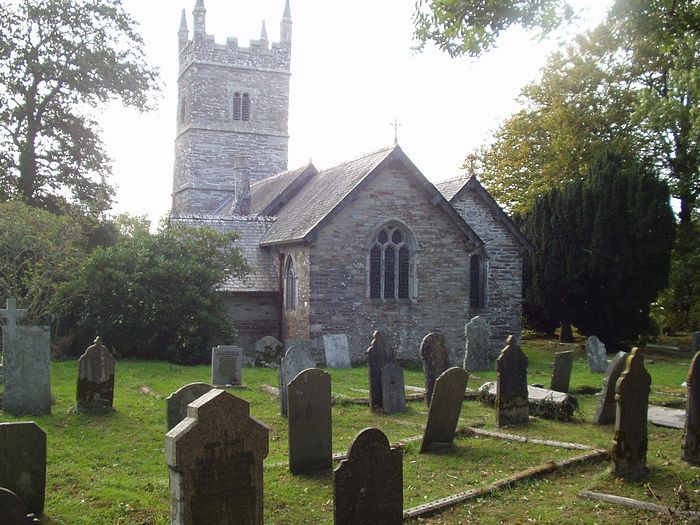 Exterior of St. Keyne's Church in St. Keyne, Cornwall (kindly provided by churchwarden of St. Keyne parish)
Exterior of St. Keyne's Church in St. Keyne, Cornwall (kindly provided by churchwarden of St. Keyne parish) Only a very late account of this saint’s life survives, written in the mid-fourteenth century by the chronicler John of Tynemouth, who composed the Lives of 156 saints. St. Keyne (also Kayne, Kaine, Keane, Kean) lived in the fifth and sixth centuries. A holy virgin and princess, she most probably hailed from Wales. The famous righteous King Brychan of Brecknock may have been her father. The holy maiden was so beautiful that young men sought her hand for years, but Keyne refused their proposals, instead taking the vow of virginity and resolving to serve God completely all her life. The saint especially strove for the ascetic life as an anchoress.
It is known that young Keyne left her native Wales and settled in the valley of the river Severn in what is now western England, making herself a hermitage there. The exact location of her ascetic life here is unknown. What is known is that the holy woman in time undertook active missionary work, perhaps aided by other Celtic saints. This extended to parts of the present-day counties of Herefordshire, Somerset and Devon in England, where in ancient times numerous churches were dedicated to her, and several places derived their names from hers. Finally the sainted virgin settled in the predominantly Celtic region of Cornwall where she led ascetic life in seclusion for many years. There St. Keyne became famous for many miracles performed by God through her prayers.
The site of her ascetic labors is traditionally identified with the present-day parish and village of St. Keyne in eastern Cornwall, where the parish church and the ancient holy well are dedicated to her. This unusual holy well appeared here through the fervent prayers of the woman saint. Tradition holds that St. Keyne blessed this holy spring and predicted that all who would drink from it with faith would receive healing, and couples would be blessed with a happy family life. According to a centuries-old popular superstition maintained to this day, the newlywed who is the first to drink some water from St. Keyne’s well will surely have dominance in the family. For many years until modern times, newly married couples have hurried to this mysterious well to drink its water before their spouse and ensure the upper hand in marriage!
Local young people and those from neighboring areas observe this tradition even nowadays. According to a popular story, in the nineteenth century, one day an anxious bridegroom left the church of St. Keyne as soon as the wedding ceremony was over and rushed towards the well (half a mile away) to secure dominance in the household, while his “wily” bride took a small bottle of the spring water from underneath her clothes (where she had hidden it beforehand) and quickly took a sip. Formerly this spring was also used as a baptismal well.
Another tradition has it that by her intercessions St. Keyne turned all the snakes of the area (they were a real plague for Cornwall and Somerset) into stones; stones in the shape of snakes resembling ossified fossils of reptiles indeed have been found in the West Country. It was written that St. Keyne visited St. Michael’s Mount—a tidal island and ancient holy place associated with the Archangel Michael to the south of Cornwall, where she conversed with her relative St. Cadoc who was living there; it was he who persuaded Keyne to come back to her native Wales.
Many traditions connect St. Keyne with regions of Wales where she indeed may have returned after many years of unceasing labors in England’s West Country. The founding of a number of chapels and churches in this country is attributed to her. The maiden of God spent the final years of her life In Wales, close to a healing spring where she reposed. She used to be the patron saint of the following Welsh settlements from the earliest times: Llangeinor in Bridgent (where a church is dedicated to her), Llangunnor and Llangain (where a church that bore her name was closed several years ago) in Carmarthenshire, Runston and Rockfield in Monmouthshire, and of Cerrigceinwen on the Isle of Anglesey (its church in honor of our saint was sadly closed down not long ago).
The parish of St. Keyne is one of the smallest in Cornwall. The unique St. Keyne’s “family” holy well sits very close to a major road and is easy of access. It was substantially restored in 1936 by a local society. The surviving stone well-house is late medieval. Its extraordinary marriage-related properties were first recorded in the early seventeenth century by the Cornish antiquary Richard Carew (1555-1620). He also wrote that St. Keyne planted four trees around the well so that their roots formed a natural chapel for the spring. Robert Southey (1774-1843), a prominent “Lake Poet”, devoted one of his ballads to St. Keyne’s well.
St. Keyne’s Church stands on high ground in the village’s southern extremity. There used to be a Norman church on this site. The present structure of Cornish granite dates back to the fifteenth to early sixteenth centuries. Its tower was built in three stages in the Cornish pattern. Over 150 years ago, St. Keyne’s Church fell into disrepair and was considerably restored in the 1870s. It consists of the chancel, the nave, the south aisle, the vestry, and the tower. Interestingly, the village of St. Keyne is served by the railway station called “St. Keyne Wishing Well Halt”. The village of St. Keyne is planning to revive the annual liturgical celebration of St. Keyne’s feast day (October 8 according to the old calendar).
The saint is also connected with Kenwyn—a suburb of Truro, the county town of Cornwall, where a medieval church is dedicated to her. Traditionally it was believed that the town of Keynsham in Somerset was named after St. Keyne, who reputedly lived nearby on the bank of the River Avon. But according to modern researchers the town’s name means “Caega’s ham” (Caegawas a given name, and “ham” was an Anglo-Saxon word meaning “a settlement”, or “a home”).
Holy Mothers Buriana, Ia and Keyne, pray to God for us!

